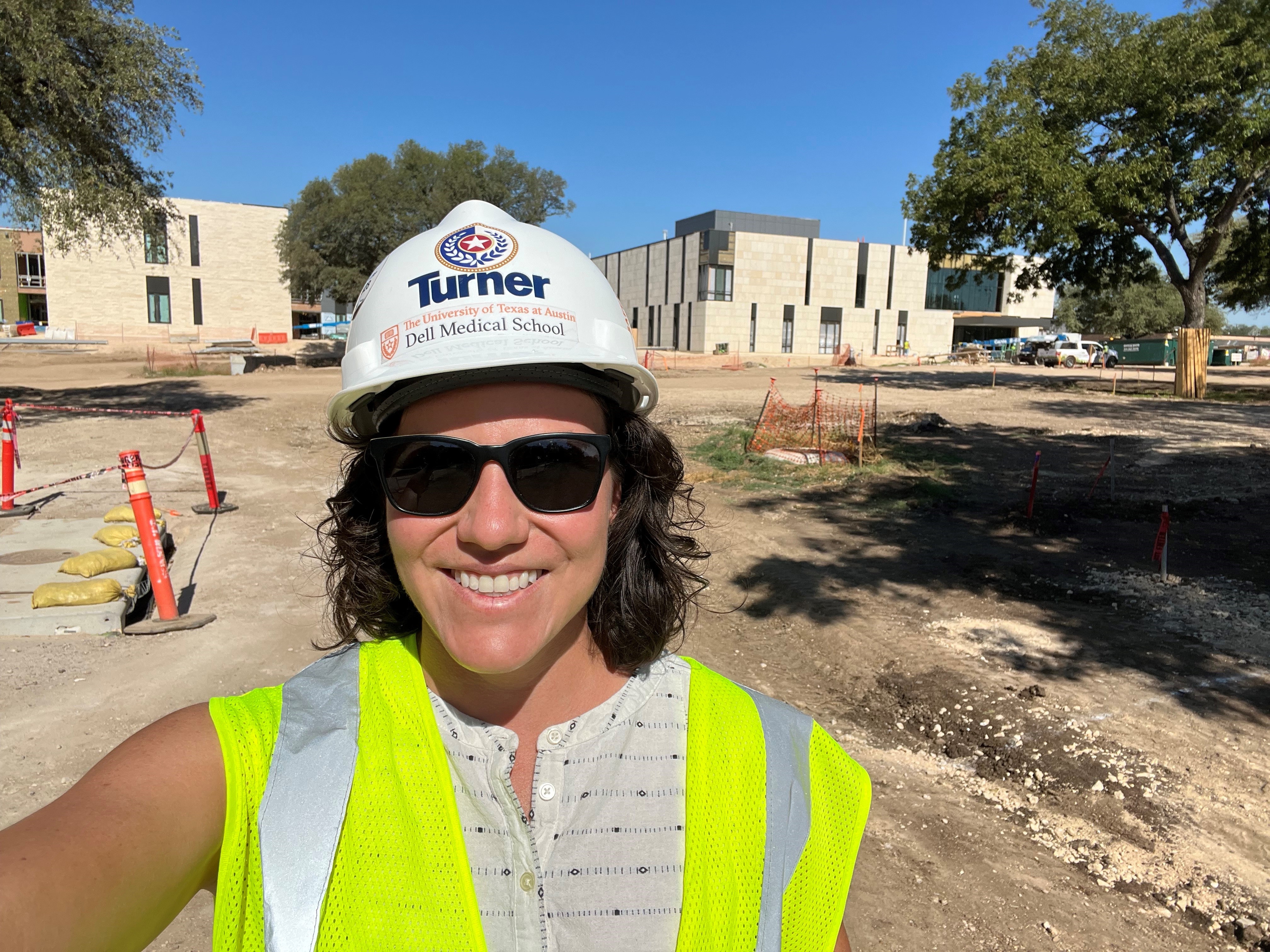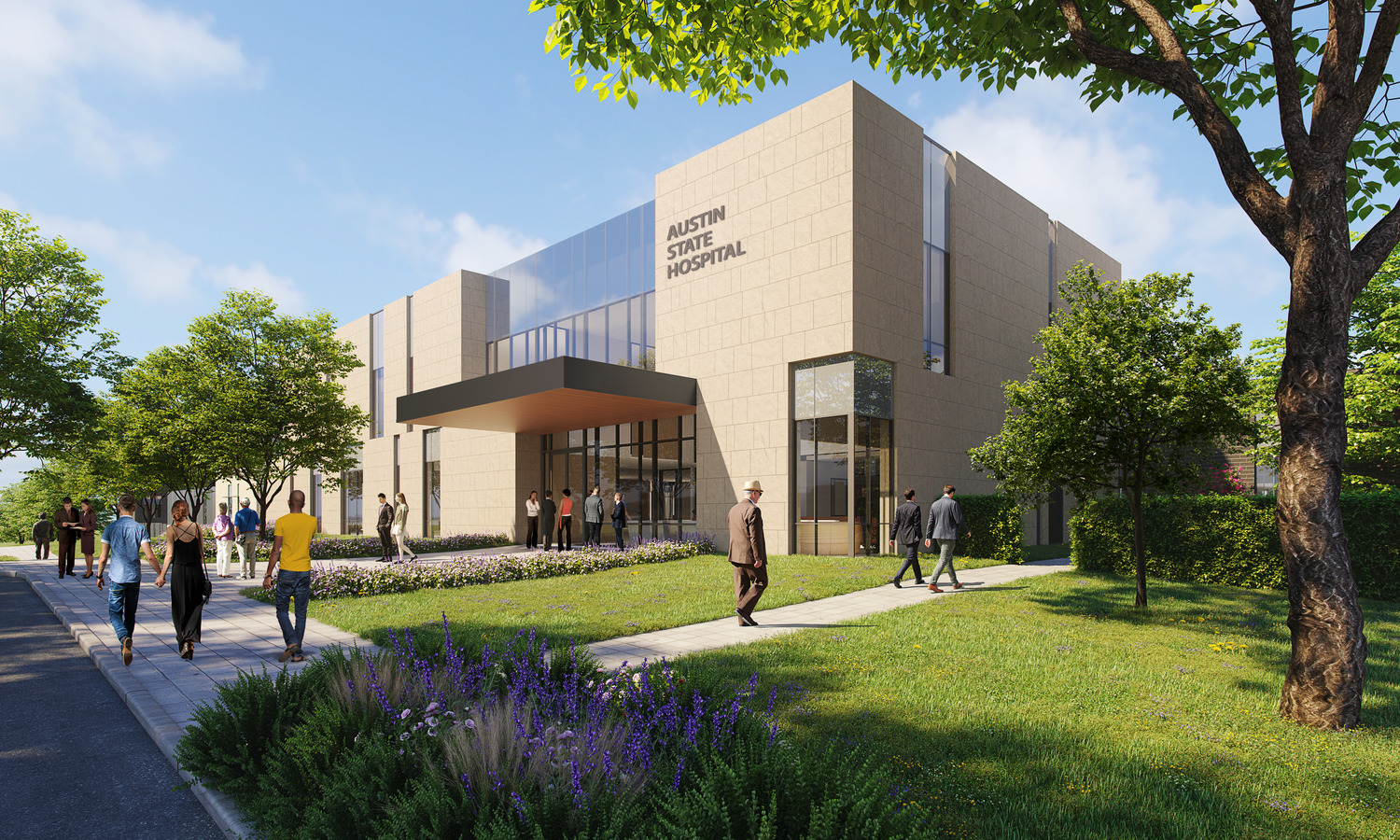 Sydney Harris, MHA, is director of mental health care redesign for the Department of Psychiatry and Behavioral Sciences at Dell Medical School (Dell Med) at The University of Texas Austin.
Sydney Harris, MHA, is director of mental health care redesign for the Department of Psychiatry and Behavioral Sciences at Dell Medical School (Dell Med) at The University of Texas Austin.
Harris is currently managing strategic and operational initiatives and architectural and engineering planning for the Austin State Hospital Brain Health Campus redesign, led by Dell Med and the Texas Health and Human Services Commission (HHSC). The redevelopment is part of a larger effort to revamp the state’s psychiatric hospital system that HHSC State Hospital System Deputy Executive Kristy Almager is leading with investment from the Texas Legislature.
Austin Mayor Kirk Watson and Steve Strakowski, MD, vice president of regional mental health at Dell Med and the Austin State Hospital Redesign project chair, are champions of setting the path to make Texas a leader in mental health care, says Harris. “But it’s about more than just building a new state hospital,” she adds. “It’s about how the whole continuum of care can be reimagined.”
The Partnership: Page architecture and engineering firm created the master plan to replace Austin State Hospital and develop portions of the hospital campus. The new hospital includes 240 inpatient beds for forensics and will provide acute and long-term care for adults from 26 surrounding counties. Page served as the prime architect of all UT Dell Med buildings in the medical district, including the design of the LEED gold Health Learning Building and the renovation of the School of Nursing building.
Three Things to Know about Reimagining a State Hospital and Brain Health Campus:
1. A spectrum of options is needed for brain health care. While inpatient services are necessary for some, earlier access to services through outpatient care can prevent or decrease the need for crisis care. “We want to provide the right care at the right time in the right place, putting the emphasis on helping people with mental health issues before they are in crisis and requiring long inpatient stays,” Harris says.

2. Inpatient brain health care needs to be accessible. A central, visible location helps to consolidate and destigmatize care. Austin State Hospital is the oldest psychiatric hospital west of the Mississippi River. Initially in a rural setting, the hospital is now located in one of the fastest growing regions in the nation. The project’s master plan emphasizes the importance of a centrally located facility as well as keeping the current hospital in operation throughout construction. “The steering committee, design team, and work groups encouraged keeping the hospital next to a main corridor of the city so as not to hide mental illness,” Harris says. “The state wants it known that we are taking care of our most vulnerable population.”
3. Building for brain health care requires a “people first” approach. Better design decisions are made with input from a facility’s users. Indeed, people with lived experiences played pivotal roles in design decisions for Austin State Hospital, visiting full-sized mockups of bedrooms and bathrooms and providing feedback on everything from lighting to room set-ups. “Any time we made a decision, we always brought it back to a person receiving care or a staff member providing the care,” Harris said. “It helped to ground us — to balance what could be the day-to-day reality within the new hospital.”
A Deeper Dive
Harris has lived in Austin since her family moved there from New Mexico. “It sounds so hippie, but my dad was in a band and music was a big part of our lives,” she said. “After attending the 1993 South by Southwest (SXSW) festival, we wanted to be in the live music capital of the world. I’m definitely an Austinite.”
Flash-forward a few decades and Harris, who has a degree in psychology from Ball State University and a master’s in health care administration from Texas Woman’s University, is taking a leadership role in improving mental health care for those in Austin and surrounding counties. “Mental health care should never be an afterthought to general health care,” Harris says.
When the Texas Legislature decided to invest millions of dollars to improve the state’s psychiatric hospitals — through modernizing care and providing more inpatient beds — HHSC contracted with Dell Med to lead a collaborative effort to redesign Austin State Hospital.

Harris, who has more than 13 years’ experience in mental health care business operations, is assisting with the rebuild of Austin State Hospital and acting as a liaison between public and private partners, architectural planners, community leaders, advocacy groups, law enforcement, and many others. “More than 130 people volunteered their time and lent their voices to this project,” she says. “They have all made this come to life.”
As the Austin State Hospital project unfolded, layers of history were uncovered. The hospital once served as a working farm, complete with physician residences. Staff and patients alike tended to animals, crops, and the campus. More than 12,000 artifacts were discovered on the grounds, some of which — an antique sewing machine, art deco sign, images, lots of buttons — are now on display at the Bullock Texas State History Museum, revealing the hospital’s rich history of resilience.
Harris and the team want to honor this history while building for the future. Care (nurse) station tops are made from reclaimed pecan tree wood found on site. And the team is incorporating historical foundations into the new construction to serve as both a reminder of the past and a practical solution for stormwater retention.
 The hospital’s redesign breaks away from the traditional institutional aesthetic. With wooden beds, custom wood-veneer millwork, and a design akin to a modern dorm room, patient rooms provide an environment that fosters recovery. “It feels more therapeutic,” Harris says. “I just walked it today, and someone was saying that the furnishings are different from the norm and are very appealing.”
The hospital’s redesign breaks away from the traditional institutional aesthetic. With wooden beds, custom wood-veneer millwork, and a design akin to a modern dorm room, patient rooms provide an environment that fosters recovery. “It feels more therapeutic,” Harris says. “I just walked it today, and someone was saying that the furnishings are different from the norm and are very appealing.”
The facility is designed to be more than a psychiatric hospital. “It’s envisioned as a place of healing and recovery,” Harris says, “with group therapy and outdoor gathering spaces, a downtown with a bank and café — much like a community environment where people can acquire the skills needed to reintegrate back into society successfully.” The hospital occupies just 15 acres of the 95-acre campus, which will also include support, administrative, and collaborative care buildings.
The project aims to shift the focus of care toward early intervention and education, as well as improving equity and accessibility. Throughout the project’s development, Harris has engaged with advocacy organizations like the National Alliance on Mental Illness (NAMI), whose involvement has been invaluable in shaping the project’s direction and ensuring it aligns with the needs of the mental health community.
“I’ve really immersed myself in this project so I could successfully advocate for it, through all its phases, to the different players and organizations involved,” Harris said.
Before the COVID-19 pandemic, the project team held an event for partner volunteers, who relocated planted rose bushes on the Austin State Hospital campus. “I was there with my baby strapped on me and my other kid in the wheelbarrow,” Harris said. “It’s been a six-year effort, but we are close to finishing. And soon, the first people will be cared for in the new, healing spaces.”